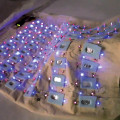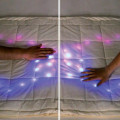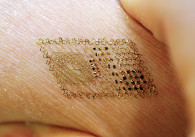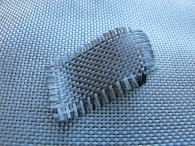As understanding evolves and resources become available, interactive textiles could be headed into the mainstream
 Harry Potter’s invisibility cloak may be fiction, but it could be a reality in the not-too-distant future. That may be a matter of physics, but perhaps a smart textile will help it along. Who would have thought a decade ago that fabrics could be made to congeal a bleeding wound, monitor and transmit bioactivity, become a personal area network, administer medications or create their own heat? These are all part of the here and now, thanks to advances in interactive textiles, or “smart fabrics.”
Harry Potter’s invisibility cloak may be fiction, but it could be a reality in the not-too-distant future. That may be a matter of physics, but perhaps a smart textile will help it along. Who would have thought a decade ago that fabrics could be made to congeal a bleeding wound, monitor and transmit bioactivity, become a personal area network, administer medications or create their own heat? These are all part of the here and now, thanks to advances in interactive textiles, or “smart fabrics.”
 It is a market segment with amazing performance qualities and perhaps equally amazing potential. According to a report by Global Industry Analysts, the global market for smart fabric and interactive textile technologies is expected to reach $1.8 billion by 2015, with major growth sectors in biophysical monitoring solutions and phase change materials. In addition, seamless integration between electronics and fabrics is expected to expand the use of electro-active smart fabrics in future applications.
It is a market segment with amazing performance qualities and perhaps equally amazing potential. According to a report by Global Industry Analysts, the global market for smart fabric and interactive textile technologies is expected to reach $1.8 billion by 2015, with major growth sectors in biophysical monitoring solutions and phase change materials. In addition, seamless integration between electronics and fabrics is expected to expand the use of electro-active smart fabrics in future applications.
Just scratching the surface
David O’Keefe, president and CEO of Advanced Fabric Technologies LLC (AFT) in Houston, Texas, is excited about the possibilities with smart fabrics and says the technology exists to do all kinds of things, but it takes patience to match it with the right companies, produce a prototype and bring it to market.
AFT makes blast mitigating, anti-ballistic fabrics that employ its patented design principle called HAY (helical auxetic yarn). This technology allows auxetic yarns to stretch at low strain rates and absorb greater energy than comparable fabrics, such as an aramid, which doesn’t move and stretch. Adding sensors or nanotubes make it “smart,” and able to provide feedback in a medical or industrial application or increase its ability to absorb and move.
The company is also developing a fluid release system that could release medication, such as a coagulant, to stop bleeding from a wound. “There’s no trick to a flat bandage, but if it can determine through sensors what the bacteria level is and self-administer medication, then it would be a smart bandage. You can incorporate all kinds of things in running shoes, bandages, uniforms. We’re just scratching the surface on this,” says O’Keefe. “I see this as our next-generation effort to be able to produce smart fabrics for existing product lines.”
The company is establishing an R & D program with Texas Tech University, which will design and develop auxetic yarns that can be tested in different disciplines, and Touchstone Research Laboratory, Triadelphia, W. Va., which will do computer modeling for test runs on different applications.
“The great thing about auxetic technology is that we have the ability to mix and match all kinds of fiber families to create the fabric that we need for that specific application,” says O’Keefe. “We’re not limited to one specific pattern, so it gives us the opportunity to explore all types of weaving and knitting. It’s so much more than military. It has a greater potential in civilian disciplines. Now it’s just talking to the right companies and getting the needed interest to produce prototypes in different applications.”
Being able to choose the starting fabric construction for certain properties and add customized conductive polymer coatings for a variety of applications is one of the most exciting trends in smart textiles, according to Dr. Jamshid Avloni, president of Eeonyx Corp. in Pinole, Calif.
The company offers a line of conductive polymer coatings that can be applied to fabrics, felts, foams, powders and plastics over a large range of tunable resistances. These are used in a range of military and commercial applications, including resistive heaters for warming blankets, all-weather boots and de-icing aircraft wings; ESD protection for clean room garments and electronics; microwave-absorbing fabrics and antennas; and dynamic pressure sensors for biomedical, sports, military and automotive applications.
“Small and large companies are keeping their eyes open and there are good reports on the state of the field,” notes Avloni. “There is a wide range of applications, and we can’t keep up with the R & D.”
Interest grows in safety and protection

Physical Optics Corp. (POC) in Torrance, Calif., is seeing some trickle-down activity from special forces in the military to law enforcement and first responders interested in its wearable networks to improve their safety and protection, according to Dr. Eric Gans, director of systems engineering. The company developed a body conformable electronic vest system called WEARNET® for soldier-worn applications. It provides vest-integrated power and data connectors for tactical radios, GPS devices and smartphones, in essence creating a wearable, personal area network.
The company is working with battery manufacturers to create batteries that conform to the body as well, and is involved in efforts to integrate intelligence into the systems and the connectors themselves to provide real-time data and power monitoring, active voltage regulation, automatic fault protection and energy harvesting.
Some clients are looking for the ability to integrate surveillance features or cell phone displays directly into the garment itself, says Gans. The company is also developing nanocoated fabrics that can seal a bullet wound to prevent the injured person from bleeding to death, and for medical monitoring purposes.
“Noninvasive health monitoring is a growing field, not just in hospitals, but also athletics. For example, football players and coaches are really keen on monitoring the concussive effect of a hit or a heart rate during really high temperatures,” says Gans.

Engineers at the University of Illinois at Urbana-Champaign have developed an ultrathin skin-mounted electronic patch that can be powered by solar cells or wireless coils and can provide physiological status monitoring and stimulation.
The electronic components—transistors, diodes and other semiconductors that are flattened and shrunk—are arranged on a sheet of rubbery “elastomer” that matches the thickness and elasticity of the skin. This makes it more comfortable and less cumbersome to wear than traditional electrodes and distinguishes it from other smart textile technologies, according to John Rogers, professor of materials science and engineering.
“It is conformal, stretchy and soft, just like the skin. As a result you can wear it without feeling it at all,” says Rogers. “It’s a new way of monitoring the human body, with future potential to also affect therapies, such as stimulation or heat.”
Besides gathering biomedical data, such as electrical signals produced by the heart, skin-mounted electronics could also help patients with muscular or neurological disorders to communicate or interface with computers. By placing the platform on the throat, it is able to distinguish muscle movement and feed signals to a computer that recognizes simple speech. The technology essentially blurs the distinction between biology and electronics, according to Rogers, and ultimately could provide an electronic link to the body’s most subtle processes and aid in tracking diseases.
“Smart” path to lower costs

Researchers at North Carolina State University (NCSU) have been focusing on the formation of functional inorganic nanocoatings on textiles, using a process called atomic layer deposition. The coatings have been applied toward new electronic devices based on a textile framework and protection of textiles from UV radiation and chemicals.
The research aims to find new applications for textiles, extending the life of textiles or applying textiles that are inherently incompatible to existing technologies to lower costs. The researchers are exploring conductive metal, transparent conductive and semiconductive inorganic coatings on textile materials, such as nonwoven nylon, polypropylene and woven cotton, for commercial applications in electronic sensing that take advantage of the flexibility and high surface areas of textiles.
Much of the emphasis on the use of smart electronic textiles is in the medical industry, particularly in Europe, says Dr. Jesse Jur, assistant professor of textile engineering, chemistry and science at the NCSU College of Textiles. Currently, atomic layer deposition technology has a good footing in the microelectronics industry, which is actively exploring low-cost, high-manufacturing processing routes. The College of Textiles is also collaborating with Dr. Gregory Parsons, professor of chemical and biomolecular engineering in the College of Engineering at NCSU, to address this challenge with textiles.
“Prof. Parsons and I hope that as the fundamental understanding of this technology progresses, we’ll soon be able to demonstrate cost-effective applications for atomic layer deposition to be used to modify the surface of textiles with added functionality,” says Jur.
In one application, they put a UV-absorbing barrier layer on the textile surface to extend the life of the textile. This would be especially beneficial on green materials, such as cotton or recycled polyester, which tend to break down more quickly under UV exposure. But if you can do a surface modification that increases its UV resistance, you can extend its life and drive down the cost of outdoor fabrics like awnings, and may even reduce the overall carbon footprint of making the material, says Jur. These coatings could also be applied to protective clothing and other applications.
“There is some really great research going on in smart textiles, using textiles for new applications. It’s a growing field and as the fundamental understanding evolves, the accessibility for small and mid-sized companies to these nanotechnologies is inevitably going to increase. Still, scaling is one of the major challenges for moving technologies from a lab to industry,” he says.
“While a lot of these technologies are really innovative, the proper resources need to be present for this transition. The resources we have available at N.C. State in the College of Textiles and the Nonwovens Institute allows for us to make the transition much easier.”
As for Harry Potter’s invisibility cloak, some researchers are exploring the physics behind it and Jur is willing to suggest that smart fabric technology could contribute to its possibility. “Using the same techniques to apply the conductive layers and UV barriers, there may soon be additional ways to change the appearance or behavior of textile products on demand.”
 TEXTILES.ORG
TEXTILES.ORG



